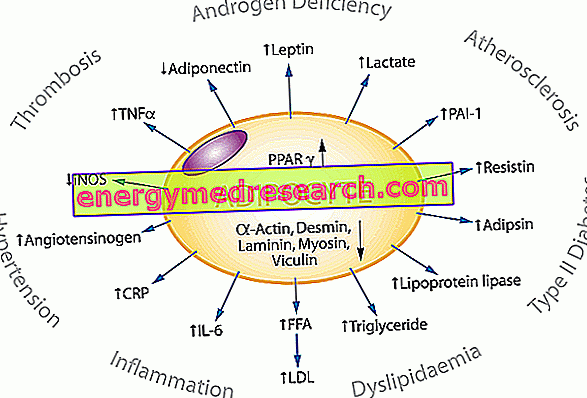What are
The term adipokine has been coined to identify in a generic way all the molecules synthesized and secreted by adipose tissue.
Obesity and Inflammation
In addition to its primary function as an energy reservoir, in fact, white adipose tissue is now considered a real source of hormones. In obesity, this secretion, in particular that of adipokines acting as peptide hormones (see leptin and adiponectin) is altered. In fact, it seems that the excessive increase in size of the mature adipocyte, typical of obese people, stimulates in some way the infiltration of macrophages responsible for the "digestion" of the enormous lipid vacuole of dead adipocytes (perhaps due to hypoxia). The consequent release of pro-inflammatory substances has particularly negative consequences on the health of the organism and predisposes to the various diseases typically associated with obesity: diabetes, and various cardiovascular diseases.
How do they work
Some adipokines act in an autocrine manner, others with paracrine mechanisms and others in an endocrine manner. The role of these substances - sometimes still to be clarified - is quite variable in relation to the adipokine considered; many of these are involved in the immune response and inflammation, while others participate in the regulation of energy metabolism.
What are they?
Among the most known adipokines we remember leptin, interleukin-6, tumor necrosis factor (TNF-a), acylation stimulating protein (ASP), plasminogen activator / inhibitor (PAI-1) and l 'adiponectin.
Some of these, such as the classic cytokines [interleukin 1 (IL-1), interleukin 6 (IL-6), Tumor necrosis factor α (TNFα)], presumably derive from inflammatory cells infiltrated into adipose tissue, whose concentration is proportional to adipocyte volume.

Some of the main adipokines:
- LEPTIN : it is a fundamental sign of satiety in the brain; it also influences various bodily activities, such as hematopoiesis and reproduction; the expression and the
Leptin secretion increases in obesity.
- ADIPONECTIN : important in the regulation of energy metabolism, promotes the oxidation of triglycerides and increases the insulin sensitivity of muscles and liver; adiponectin expression and secretion decrease in obesity.
- ASP : increases glucose uptake in adipocytes, inhibits hormone-sensitive lipase and activates diacylglycerol acyltransferase. It has therefore a stimulating activity on the synthesis of triglycerides and inhibitory on the oxidation of fatty acids.
- TNF-α : the excessive production of this substance by adipose tissue is related to insulin resistance in the obese. In fact, it increases liposis and the consequent increase in circulating FFA; at the level of muscle tissue, it reduces the expression of the GLUT-4 glucose transporter. It also sends the fatty adipose cells in apoptosis, deputed to auxiliary thermogenesis, and reduces its functionality.
- PAI-1 : is a causative factor in vascular thrombosis.
- RESISTINE : inhibits glucose uptake in skeletal muscle cells.



